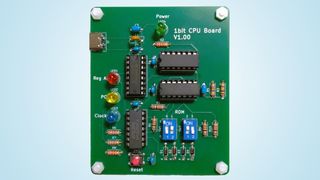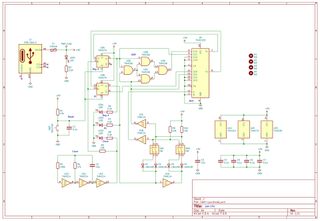1-bit CPU for ‘super low-performance computer’ launched – sells out promptly
Device is programmed with DIP switches to operate an LED. That's it.

A newly launched single board computer (SBC) kit allows the buyer to assemble and run a 1-bit CPU. Japan’s Switch Science released the 1-bit CPU assembly kit last week, boasting that it is “one of the world's top-class low-performance computers.” Despite the mixed messages in its claim to fame, PC Watch notes that supplies of this Naoto64-designed DIY computer sold out quickly. The “super low performance computer” only runs at approximately 1 Hz, has a bus width of 1 bit, an address space of 2 bits, and a ROM capacity of 4 bits.
Releasing a new product that claims to be a “super low performance computer,” kind of turns decades of computer progress and marketing on its head. The pages of Tom’s Hardware usually celebrate processors that push the boundaries of what is possible in the consumer sphere and beyond. However, we are interested in computing within extreme restraints (physical sizes, temperatures, system resources, etc.), which pushes one of those buttons and may appeal to makers and DIYers.

The Switch Science product page echoes the content of Naoto64’s GitHub page. Whichever source you read, the overview of the kit is as follows:
“This is a 1-bit CPU assembly kit using 4 logic ICs. Because it is a super low performance computer, it can only do one of the following: L flash, LED on, or LED off. It is one of the world's top-class low-performance computers.
The power source is a USB Type-C terminal. AC adapter and cable are not included, so please prepare them separately. Also, please note that power delivery such as PowerDelivery is not supported.”
Unsurprisingly, Naoto64’s device has a very limited instruction set, offering just ‘ADD’ and ‘JMP’ instructions and the single arithmetic operation ‘XOR.’ To program the 1-bit CPU board, you won’t be mousing around or typing on a keyboard. Instead, this device needs its operator to set the positions of the four ROM DIP switches. In terms of raw specs, this “super low-performance computer” only runs at approximately 1 Hz, has a bus width of 1 bit, an address space of 2 bits, and a ROM capacity of 4 bits.
In case you missed it, when fully assembled and powered up, this device can do just three things: flash an LED, turn the LED on, and turn it off. Do we need to say it can’t run Crysis or DOOM?
Stay On the Cutting Edge: Get the Tom's Hardware Newsletter
Join the experts who read Tom's Hardware for the inside track on enthusiast PC tech news — and have for over 25 years. We'll send breaking news and in-depth reviews of CPUs, GPUs, AI, maker hardware and more straight to your inbox.
Naoto64 shared a video demo of a pre-production version of the 1-bit CPU if you can handle the excitement (above). The new kit looks far neater – but the finished user-assembled product’s neatness will also depend on nimble-fingered soldering skills.

The 1-bit CPU assembly kit comes as a set of parts. The Switch Science supplied SKU 9376 package looks like a simple ziplock bag with approximately 50 components inside, plus the unpopulated PCB and set of printed instructions (also available as a PDF to download). This product is advertised at a modest ¥2,500 in Japan (about $18), which would have made it a great geeky Christmas stocking filler for those quick enough to grab one of the first batches. We don't know when stocks will be replenished.

Mark Tyson is a Freelance News Writer at Tom's Hardware US. He enjoys covering the full breadth of PC tech; from business and semiconductor design to products approaching the edge of reason.
-
Steve Nord_ Now shipping the brickout edition. There is a brick and it is out. Delivery in 7-10 weeks.Reply -
Sippincider ReplyWhen fully assembled and powered up, this device can do just three things: flash an LED, turn the LED on, and turn it off.
Nice, buy why does it need (4) ICs to accomplish this?
Instead of hanging a processor on everything today, I'd be more impressed with clever circuitry and a minimum number of components. -
Eximo Are you asking why a CPU made of discrete common DIP packages needs 4 chips? Because it is made from off the shelf parts you used to be able to pick up at Radio Shack. Look at the video thumbnail, a breadboard.Reply
Likely a very power inefficient solution, but good luck getting a company to produce this circuit as an integrated chip. All the costs would be in the packaging and you would still need a board for I/O. -
jbo5112 Reply
They are VERY basic integrated circuits, so small that all of the chips have multiples of each circuit. I had to buy some of these for an introductory class on digital circuits.Sippincider said:Nice, buy why does it need (4) ICs to accomplish this?
Instead of hanging a processor on everything today, I'd be more impressed with clever circuitry and a minimum number of components.
(74HC74) Dual D Flip−Flop with Set and Reset (8x 2-input NAND gates & 2x NOT gates)
(74HC153) Dual 4-input multiplexer (4x 3-input NAND gates & 2x NOT gates)
(74HC14) Hex Schmitt−Trigger Inverter (1x NOT gate & 2 resisters)
(74HC00) Quad 2-Input NAND Gate (1x 2-input NAND gate, 4 of them in a package)The product names are even an industry standard: https://electronicsclub.info/74series.htm -
vehekos We don't need a hardware solution when we have Windows.Reply
We can even run python on windows and easily beat all the slowness it can give. -
FoxtrotMichael-1 Man you guys in this forum have absolutely no imagination. The point of the kit is to be a fun educational novelty if you enjoy computer architecture and extremely simple logic circuits. The chips are more complex and less efficient than required because they are off-the-shelf components used to build the educational demo. If you made a custom IC it would drastically increase the cost at these low production runs and if you simply made an analog circuit that could do the same job it would no longer be educational about computer architecture or novel.Reply -
DougMcC Reply
I think so. I believe add, jmp, xor is sufficient for turing completeness. You'd have to provide a substantial external storage and display obviously.Crazyy8 said:Can it run Quake? -
Engineer12 Underwhelming, since Motorola manufactured a 1-bit CPU almost 50 years ago. You can still buy them on eBay.Reply
https://en.m.wikipedia.org/wiki/Motorola_MC14500B
Most Popular




